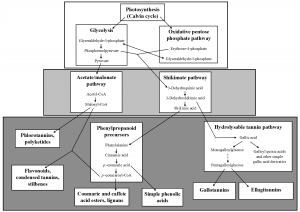Polyphenols or their immediate building blocks are derived via two main pathways and one tannin group may rely on one or both of the pathways
Plant cells (chloroplasts) fix carbon dioxide via the Calvin cycle into glyceraldehyde-3-phosphate, which can be further transformed and accumulated into storage carbohydrates such as sucrose and starch. These are then degraded when necessary either by glycolysis (main products: glyceraldehyde-3-phosphate, phosphoenolpyruvate and pyruvate) or through the oxidative pentose phosphate pathway (main products: erythrose-4-phosphate and glyceraldehyde-3-phosphate) into more simple molecules. Glyceraldehyde-3-phosphate has a special role, since it is readily available from the Calvin cycle, and can be partitioned between the two carbohydrate-degrading pathways as well, depending on demand.
The first branch of the pathway occurs between the acetate-malonate and shikimate pathways. Both of these pathways are essential for the biosynthesis of PAs, while ETs rely solely on the shikimate pathway. If significant levels of glycolytic phosphoenolpyruvate are directed for the shikimate pathway (together with erythrose-4-phosphate), the production of pyruvate for the needs of acetate-malonate pathway is significantly reduced. This has direct negative effects on PA biosynthesis, since they would need malonyl-CoA as one of their building blocks. However, all plant tannins rely on the efficient function of especially the shikimate pathway, while the phlorotannin-producing brown algae only need the acetate-malonate pathway for their tannin synthesis.
The second major branch point occurs at 3-dehydroshikimic acid. This is the precursor for the synthesis of gallic acid, the primary building block of all HTs. Efficient production of gallic acid negatively affects the synthesis of shikimic acid and its products: PAs, flavonoids, and caffeic and coumaric acid derivatives. The hydrolysable tannin pathway contains a third major branch point at pentagalloyl glucose, the precursor for bothGTs and ETs. To date, there are no reports of the simultaneous production of significant amounts of both of these hydrolysable tannin classes in the same plant tissue. Moreover, coniferous plants are only reported to synthesize PAs and never HTs.

